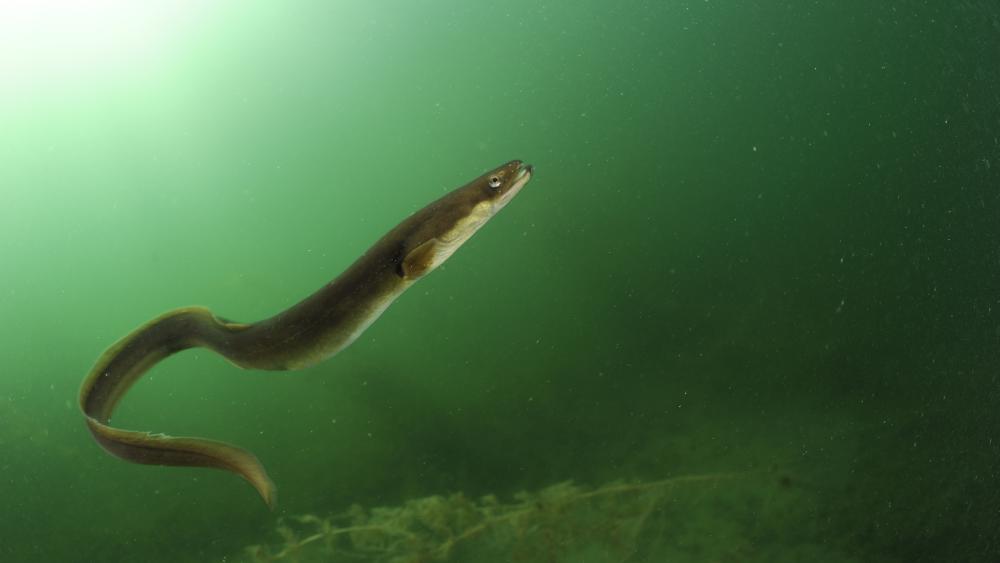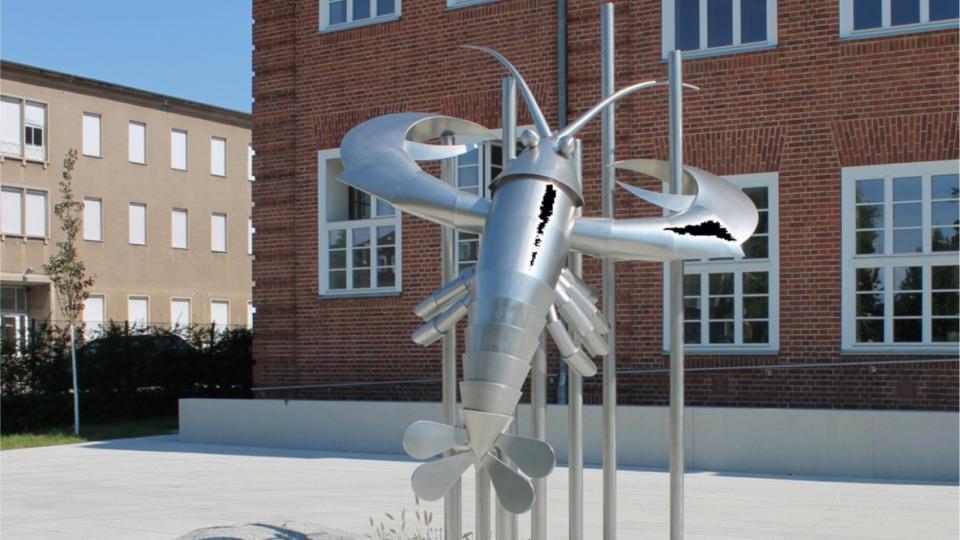
Eel in Lake Stechlin. Biodiversity in inland waters is important for us humans in many ways. | Photo: Solvin Zankl
Animal and plant species in freshwater are particularly endangered: animal populations in rivers, lakes and wetlands, for example, are shrinking twice as fast as those in the sea and on land. And according to the World Conservation Union's (IUCN) Red List of Species, updated in 2022, one-third of freshwater animal species are threatened with extinction: around 59 per cent of turtles, 20 per cent of fish, 37 per cent of mammals and 30 per cent of amphibians.
Species extinction is also linked to dwindling habitats: wetlands worldwide shrank by a third between 1970 and 2015; a decline that is three times as high as the loss of forested areas. Only one third of all major rivers can still flow unimpeded, i.e. without barriers such as dams or other obstacles, into the sea.
Humans depend on biologically diverse waters
"There is an ethical imperative to protect nature, but at the same time we should also understand that we are critically dependent on important biodiversity functions and services in freshwater ecosystems and that we urgently need to slow down the loss of biodiversity," said study leader Sonja Jähnig, head of department at IGB and professor at Humboldt University zu Berlin.
Sonja Jähnig and a large international team of researchers and representatives from nature conservation have summarized the most important functions that depend on freshwater biodiversity in the journal WIREs Water. Following the framework of the Intergovernmental Science-Policy Platform on Biodiversity and Ecosystem Services (IPBES – analogous to the IPCC for nature), the authors differentiate between material, non-material, and regulating ecosystem services of biodiversity, assigning three important functions or services to each category and giving scientifically sound examples.
9 important ecosystem services of freshwaters we cannot do without
1) Food: Although we first think of fish when we think of food from the water, the spectrum is actually large and ranges from animals to plants to microorganisms.
2) Other animal and plant products: Materials from freshwater are used to make utilitarian and ornamental items, such as clothes made from fish leather, nail files from fish scales and scissors from piranha teeth. Aquatic plants are used as building materials and furniture.
3) Health and genetic resources: Algae, aquatic plants and animal products – from collagens from fish to secretion products from frog skin – are used in medicine and pharmacology.
4) Recreational value: The recreational activities enabled by freshwater biodiversity are considered cultural services. Swimming and boating take place where the water quality is considered good. This is directly related to the living organisms in the water body, which can prevent algal blooms, for example.
5) Importance for culture, religion and spirituality: Almost all cultures around large lakes or rivers have rituals and traditions linked to the living creatures there.
6) Opportunities for education and technological advancement: Formal curricula in primary schools to targeted extracurricular activities for youth – all help to build connections and foster a lifelong commitment to freshwater conservation and responsible stewardship.
7) Climate regulation: Freshwater ecosystems are critical for carbon and methane storage and sequestration.
8) Catchement integrity: Riparian and aquatic plants reduce water velocity, improve bank stability, retain sediments and filter nutrients and pollutants.
9) Self-purification of water and nutrient cycles: Billions of microorganisms, plants, algae and animals clean the water by filtering excess nutrients, pathogens and pollutants. This is crucial for drinking water production, among other things.
"Freshwaters have been managed primarily as an important resource rather than as THE special and sensitive habitat for an extraordinary variety of organisms that provide all these functions. Policymakers can integrate biodiversity conservation more fully into water management," summed up the study's first author Abigail Lynch of the United States Geological Survey (USGS) Climate Adaptation Science Centers.
Sustainable management of water bodies: Biodiversity enables nature-based rather than technical solutions
In their publication, the authors also discuss Nature-based solutions that optimally combine nature and species conservation with human benefits: While technical measures such as dams, canals, dykes or measures for water treatment measures are often dominant approaches to water-related socio-ecological challenges, Nature-based solutions are measures that protect, sustainably manage and restore ecosystems while benefiting human well-being and biodiversity. "Often, contrary to popular belief, nature-based solutions are cheaper and more efficient than engineered solutions. For flood protection, for example, it can make much more sense to use the retention capacity of floodplains than to build higher dams," Sonja Jähnig noted.
Freshwater plants stabilise shorelines and can significantly reduce flooding, soil erosion and water pollution. Hydropower facilities even recognise this value of a Nature-based solution, finding it cost-effective to restore and maintain intact shoreline vegetation in upper catchments to prevent erosion, decrease the sediment load to reservoirs, reduce dredging costs and increase the lifespan of dams.
Constructed wetlands are one of the most common Nature-based solutions used as alternative to control urban water pollution from rainwater, combined sewer overflow and outflow from wastewater treatment. Taking this a step further, the concept of "sponge city" has been implemented on a large scale in China: Large wetlands that had once been developed were restored and additional wetlands created with the idea that these features would function like sponges, absorbing runoff and mitigating flood events while creating biodiversity rich areas within urban centres for people to enjoy.
Fascinating facts about the benefits of freshwater biodiversity
Food: Fish are an extremely important source of protein in countries with food shortages and one freshwater plant feeds half the world's population
In 2022, the database of the Food and Agriculture Organisation of the United Nations (FAO) included 2,500 different species of edible freshwater fish alone. Especially for low-income countries and those affected by food shortages, inland fisheries are an important source of food. A study on the socio-economic value of freshwater species in the North African region, for example, found that of the 128 freshwater fish species included in the study, more than half play an economic role and are used as an important food source. However, more than a third of these exploited species are threatened with regional extinction there.
In the lower Mekong Delta, 2.3 million tonnes of fish and other species are caught annually. These provide about 50 to 80 percent of the animal protein for the region's diet. Many of the fish species there are migratory, so the massive expansion of hydropower is threatening food security in the Mekong Delta - along with other man-made stressors such as water pollution and climate change.
The rice plant Oryza sativa, which feeds half the world's population, is also a freshwater species. While O. sativa is produced at a large scale to feed billions of persons, other varieties of rice are produced for local communities. China has a long history of macrophytes consumption and this country has currently a large-scale production and consumption of freshwater plants.
Clean water: Wetlands for water purification
Wetlands are important for water purification. A well-known example is the Nakivubo Swamp and Kyetinda Wetland near Kampala, Uganda, which receive and filter much of the city's wastewater before it enters Lake Victoria. The economic value of the swamp's wastewater treatment and nutrient retention is estimated to be worth up to US$1.75 million per year. The loss of this service would lead to numerous negative consequences, such as fish kills, toxic blue-green algae blooms and exposure to human faecal bacteria and viruses.
Climate regulation: peatlands as carbon sinks
Algae and aquatic plants, especially in wetlands, play an essential role in absorbing and storing atmospheric carbon in the form of living plant tissue and decomposed vegetation. It is estimated that wetlands and peatlands store about 20-30 per cent of global carbon and thus play an important role in the atmospheric carbon cycle. Protecting natural peatlands and wetlands is also climate protection.
Cultural value: symbolic animals are doubly extinct - physically and socially
Freshwater biodiversity is the basis for a wide range of cultural services that encompass religious, spiritual and social experiences and play a key role in forging people's identities. Almost all cultures around large lakes or rivers have rituals and traditions linked to the living creatures there. In the Amazon region, cultures are closely interwoven with their river and with the large animals, such as the arapaima (Arapaima gigas) or the Arrau turtle (Podocnemis expansa), which are highly endangered.
In Europe, crayfish in particular played an important role from the Middle Ages onwards as a symbol of fortitude and resurrection - the latter through its ability to shed its skin and thus renew itself. Crayfish therefore adorn coats of arms and flags in many regions. Freshwater crayfish are threatened with extinction in Europe. When these animals become extinct, the cultural memory is lost with them. They die out twice, once physically and once “socially“.

9 reasons why we humans urgently need freshwater biodiversity. | Graphic: The authors of the article in WIREs Water

Nature-based solutions, such as flood protection through floodplains, are often more efficient than technical solutions. | Photo: shutterstock_1073271503

Crayfish, particularly the native European crayfish Astacus astacus, are integrated into diverse cultural celebrations around Europe, featured on coats of arms, in regional sayings, and statuary as shown here in Cottbus, Germany | Photo: svolks, CC BY-SA 3.0







